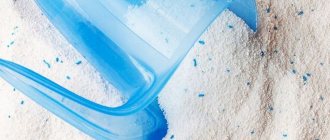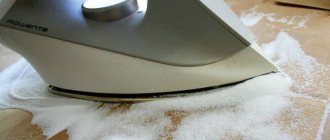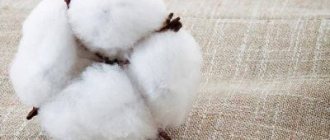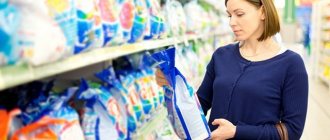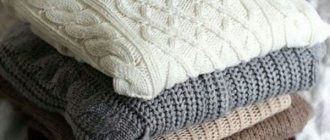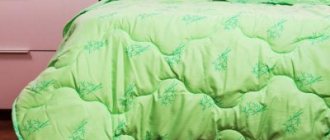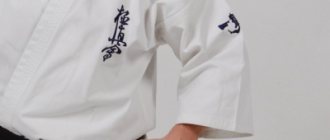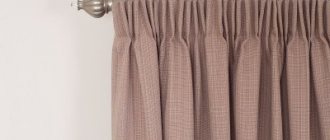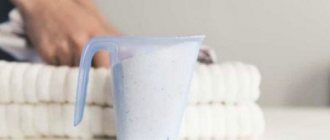What are they and why are they needed?
Enzymes in washing powder are represented by organic enzymes of protein origin. In living organisms, they are produced by cells and used by them to ensure metabolic processes.
In laundry detergent, enzymes are responsible for breaking down dirt molecules. Their presence in the composition indicates that the quality of the wash will be higher.
Enzymes act on various types of stains:
- protein,
- fat,
- combined,
- dyes.
Enzymes are available in granular and liquid form. They can be single or multi-component. Depending on the composition of the powder, manufacturers color the enzymes in different colors.
The share of enzymes in modern washing powders does not exceed 30-35%.
However, technologists claim that even their slight addition to the composition significantly increases its cleaning ability. to add to washing powders , including:
- Savinaza,
- Totalase Ultra,
- Sokolan,
- Natalaza 60,
- Purafect and others.
Which ones are used in production?
The following enzymes are used in the production of washing powders:
Alkaline protease .
This enzyme is responsible for the destruction of all protein-containing contaminants. It can be used to remove stains from blood, milk, eggs, cocoa, grass, and butter. These particles are practically insoluble in water and quickly settle on tissues. When they bind to protein, they form peptides that are easily broken down by the detergent composition.- Alkaline lipase . This enzyme works great with fats and oils. They are the main helpers in the fight against stains from sweat and fatty foods.
- Amylase. It is responsible for removing contaminants containing starch from things, for example, stains from potatoes, baby food, and chocolate. Having bound the molecules, amylase breaks them down into saccharins and dextrins, which dissolve well in water and are washed out of the fabric fibers.
- Cellulose. This enzyme gives a special smoothness to things made from cotton fabric. Under its influence, the fibers become elastic and less electrified. Thanks to this effect, it is possible to get rid of contaminants that were stuck on the bristling villi. As a result, the fabric becomes lighter and more pleasant to the touch.
- Alkaline pectinase . This enzyme is used to combat fruit stains.
- Keratinases. This type of enzymes easily breaks down the remains of dried protein and ensures high-quality leaching of dead skin cells from the tissue fibers.
Enzymes have been used to produce laundry detergents for over 40 years. The “pioneer” among enzymes is alkaline protease.
Classification of pollution
Enzymes are often added to household chemicals to give them special cleaning properties. Before considering the features of their action, we will tell you what groups of stains the stains need to be divided into in order to remove them effectively.
Waste products
These include not too persistent, but daily encountered contaminants: secretions of sweat glands, particles of dead skin, bacteria. They are always present on underwear. If not removed in a timely manner, such particles form an oil film on the surface that is poorly soluble in water. Soot and dust settle on it, developing into pigment-oil stains.
Food
Formed when we get our clothes dirty while eating. This group, in turn, can be divided into several categories depending on the product that left the stains:
- Fat and oil (sunflower, olive, butter, etc.).
- Proteins (ice cream, egg whites, blood, milk, etc.)
- Dyes (wine, strong tea, cocoa, vegetables, etc.)
- Fiber and starch (pasta, porridge, etc.)
- Combined.
It is important to promptly remove particles of food ingredients from clothing. Immediately upon contact with fabric, they can only leave a clean wet mark. But over time, dirty particles from the environment stick to it, significantly complicating the cleaning process.
Dusty
They are constantly present in the air around us. They are very small, so they are invisible when viewed with the naked eye. But if things are worn for a long time without washing, a uniform layer of plaque forms on them. Fabrics can get dirty:
- Dust.
- Pollen.
- Burnt and soot from incomplete combustion of raw materials.
- Soot.
- Road reagents.
- Rubber dust from wheel abrasion, etc.
All of the listed types of stains can be divided into four groups depending on the components used to remove them:
- pigment-oil;
- protein;
- water soluble;
- colored non-protein.
Are these substances harmful?
Enzymes are one of the few components in washing powder that do not pose a threat to human health. They are absolutely safe as they are of natural origin .
Enzymes are not capable of causing an allergic reaction or skin irritation, so they can even be found in baby powder.
Enzymes are non-pathogenic substances . If sanitary and hygienic standards and technologies are observed during their production at the enterprise, then they will not cause harm to the human body.
Bio phase
To understand this option, you need to understand how stains are removed in the washing drum. The components of washing powder (enzymes) are activated by hot water and penetrate the fabric fibers, dissolving organic contaminants. The optimal temperature for this is about 40 °C.
CHIP recommends: washing machine with bio-enzyme phase
In bio-phase mode, the water is heated or cooled to this temperature for 10-15 minutes so that the enzymes can penetrate the stains. This phase can be added to any wash program. If you often have to remove stains of natural origin - coffee, grease, blood, sweat, sauces - the presence of such an option will significantly increase the efficiency of washing.
How to use laundry detergent correctly?
Housewives are accustomed to the fact that to remove stubborn stains, things need to be washed in hot water, and sometimes even boiled. However, this rule does not apply to powder with enzymes. They are biological drugs that are destroyed at high temperatures. Boiling neutralizes them 100%.
Recommendations for the use of washing powders with enzymes:
Before using the detergent for the first time, you should read the information on use indicated by the manufacturer on the packaging;- to remove protein stains, the water temperature should remain between 30-40 degrees;
- to combat complex contaminants, the water temperature can be increased to 60 degrees;
- for the best quality of washing, things need to be soaked in warm water - this will allow the enzymes to fully demonstrate their activity and dissolve protein stains, and subsequent washing in hot water will be aimed at removing traces of fat.
Safe washing powders
There is a worthy alternative to washing powders with surfactants. More than ten years ago, European countries and some US states began producing phosphate-free powders. Japan has achieved the greatest success in this area, where surfactants have not been added to washing powders since 1986.
Many housewives refuse to use hazardous powders and switch to SMS (synthetic detergents) without phosphates. There is an explanation for this:
- Completely decompose and therefore environmentally friendly;
- Odorless and safe for allergy sufferers;
- Do not dry the skin on your hands when washing by hand;
- They are completely washed out of laundry and do not leave a residue on things;
- Wash effectively even in cool water.
The disadvantage of phosphate-free powder is its high price. However, if used sparingly, it can be practically reduced to zero. One kilogram of this product is enough for at least 100 kilograms of dry laundry.
There are several ways to reduce the harmful effects of detergents containing surfactants. It happens that it is not possible to buy a harmless powder - for example, if it is not sold in the city or it is too expensive.
Important: the damage caused by the powder does not depend on the washing method. That is, it does not matter whether the items are washed in a washing machine or washed by hand.
Microparticles still end up in the lungs. Laundry does not help, since the powder particles, firmly held on the fabric, enter the bloodstream almost instantly after contact with the skin.
To reduce harm from SMS you need to:
Raise the temperature of the rinse mode to 75-80 degrees and increase the number of spin times to 7, or better yet, more. Cold water does not wash away surfactants. It is more difficult to remove phosphates from things containing wool;
- Try to purchase powders with a reduced odor, or better yet no odor at all (hypoallergenic);
- Do not allow the product to come into contact with your skin and use gloves when washing and do not breathe the powder;
- Dry washed items for at least two to three days;
- After finishing work, ventilate the room where the washing was carried out.
Features of choice
Different enzymes exhibit different activity against certain types of stains. However, it is impossible to find washing powder in the store that would contain all enzymes at once. This is because enzymes are substances that react with other components that make up laundry detergents.
For example, bleaches in high concentrations can slow down their work , and sometimes even cause their destruction. Therefore, manufacturers have to find a compromise by depriving the powder of one of the components.
If a buyer wants to purchase a laundry detergent with enzymes, he needs to familiarize himself with the composition. Among other substances, it should contain enzymes.
Top 3 best
You can find various washing powders containing enzymes on sale, but the top three included only the safest formulations, which have many positive reviews from consumers:
Persil Sensitive
This powder from the famous German company Henkel is in demand among Russian consumers . The formula is designed in such a way that it can be used to care for children's clothes and clothes of people with hypersensitive skin. High quality washing is ensured by the presence of enzymes and bleaches in the powder.
The price of a package weighing 3 kg is 350 rubles. Read reviews here and here.
Attack Multi Action
This is a Japanese highly concentrated laundry detergent containing oxygen stain remover and fabric softener. The formula of the detergent is enhanced with active bioenzymes , which wash away stubborn dirt, eliminate greasy items and help remove unpleasant odors. After washing, the products will emit a floral aroma.
The cost of a package weighing 0.9 kg is 825 rubles. Reviews can be found on this review page. Read more about the detergent in this article.
Frosch
This washing powder is made in Germany. It can be used for hand and machine washing, for items made from different types of fabrics . Frosh is suitable for washing children's clothes. The composition contains enzymes and bleaching components that ensure high-quality removal of contaminants. The powder does not contain fragrances or phosphates.
Price – 600 rubles per package of 1.08 kg. Reviews can be read here and here. This publication will tell you more about the detergent.
The composition and purpose of the components of washing powder are discussed in this section.
Advantages of CHISTOWN CHILDREN washing powder
Natural powder CHISTOWN CHILDREN has the following distinctive features:
- does not contain phosphates, chlorine, zeolites, a-surfactants and other toxic substances
- made from natural raw materials
- contains more than 30% natural soap
- protects against scale
- low consumption due to high concentration of natural soap
- high percentage of removal of natural stains from white and colored linen
- does not contain artificial fragrances and has a slight smell of natural soap, which completely disappears after rinsing
- almost completely decomposes, does not clog pipes and does not harm the environment
- does not cause allergies or irritation
Natural powder CHISTOWN CHILDREN is an ideal product for washing children's clothes and linen. Many powder manufacturers use active chemicals that can be hazardous to children's health. CHISTOWN CHILDREN'S powder consists of 100% only natural ingredients: soap, soda and citric acid. Our technologists do not use any chemical compounds, additives or flavors to completely eliminate any possibility of an allergic reaction or skin irritation in children. Using this powder for everyday laundry, you can be completely sure that it is safe for children.
Many mothers in our country continue to wash their children’s clothes with regular baby or laundry soap, grated. This method of washing is safe, but has several obvious inconveniences. Firstly, it is labor-intensive and time-consuming. Secondly, large soap shavings are not recommended for use in machine washing, as they can lead to clogged pipes and rapid wear of the washing machine. We produce washing powder from natural fine powder soap, adding a little soda and citric acid. The resulting powder - CHISTOWN CHILDREN - is suitable for washing in any type of washing machine.
CHISTOWN CHILDREN'S washing powder is an effective detergent and can cope with various natural stains on children's clothing and linen. The powder is suitable for soaking and daily washing.
No flavorings are used in the production of baby powder. CHISTOWN CHILDREN has a light scent of natural soap. After washing, children's clothes and underwear will not have any odor.
CHISTOWN CHILDREN'S powder is also suitable for washing adult clothes. Now you don’t need to buy separate detergents for regular laundry and for washing children’s clothes. This powder solves all problems. The powder is very economical, has a small dosage, which can significantly reduce washing costs.
